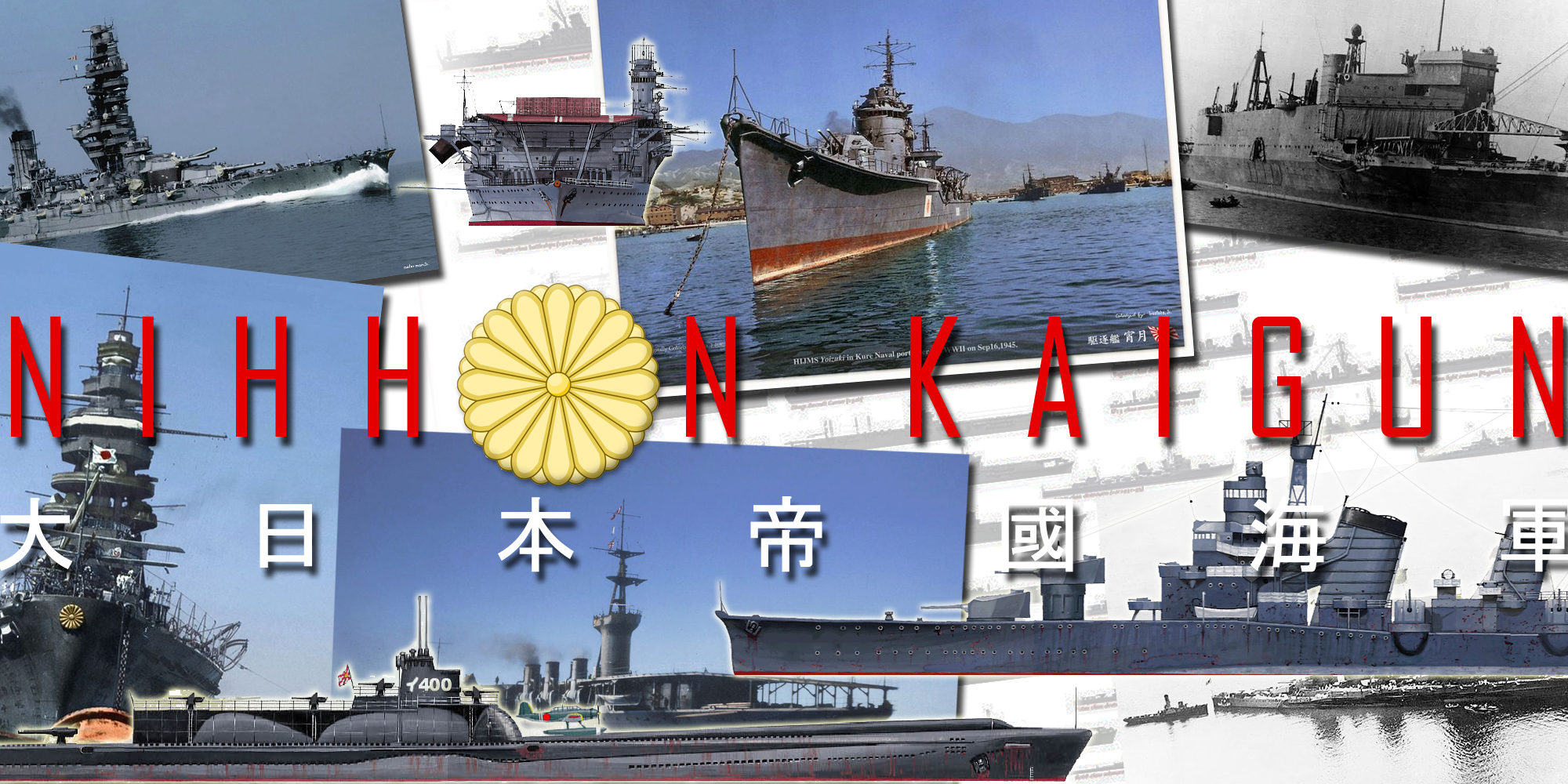
Imperial Japanese Navy WW2
At the service of the Emperor: The Japanese Navy (Nihhon Kaigun) is still a relatively new creation in 1941, she is only 60 years old. Indeed, the milestone in the history of Japan is the moment when Commodore Perry landed in 1853 in Edo to successfully submit a trade treaty between the US and the empire, benefiting by extension to other powers of the moment (including France and Great Britain). This was not the first, but was the only one to succesfully open Japan (by the pressure of a modern fleet).
Since then, Japan experienced a troubled transition and civil war between pro and anti-openness, all declared in the service of the emperor, but also an industrial transformation at a speed rarely matched in history.

The Yamato would remain the largest battleship afloat
Origins
By the 1860s there was no proper “navy” but a collection of private fleets of the warring clans, consisting mainly of junks and galleys, many equipped with bronze artillery pieces. The technological gap was such that it took a transition period to industrialization of nearly thirty years. The Meiji Era with the end of the civil war, consecrated the constitution of a homogeneous fleet in the service of the Shogun, with since 1855, the assistance of the Dutch.
Thus are born the first sea going Japanese war vessels. The navy was officially founded in 1869. Germans, French, Americans and British, proposed and obtained various contracts. Subsequently, the French and especially the “young school” under the aegis of Emile Bertin were going to be more and more present in this area and provide Japan with many ships until 1895 and set up some institutions.
But after a few failures (including the mixed battle of Yalu in 1894) and the loss of a cruiser due to a bad design (Unebi), the Japanese turned definitively to Great Britain for the supply of their ships, guns, technicians and training through a new naval academy and tactics refined by learning directly in the Royal Navy as observers, while the army was modelled by the Prussians after the French loosing in 1870.

Global view of the IJN (poster available)
1905, the IJN fleet golden age
Thus the fleet that fought the Russians at Tsushima in 1905 was largely modeled on the British Royal Navy, almost an Asiatic clone. Battleships, cruisers were British-built (with the exception of two French and one German). Destroyers and later cruisers were produced locally, first on adapted foreign plans.
The academy and trainig course included mandatory trips in UK, and at least two generations of officers were trained with the Royal Navy and used RN tactics. Japan continued to build up an ever-growing fleet during the Great War, where a relentless chase against German units took place. Not content to copy, Japanese engineers innovated, as with the Satsuma, the first “monocaliber battleship” preceding by one year the famous Dreadnought, but eventually completed in a more classic way due to lack of equipment, but still quite a poerful secondary battery.
In also, 1918 the Hosho became the world’s first aircraft carrier. Out of the great war grandiose naval plans, Japan’s authorities bitterly resented the Washington treaty restrictions, as a racist empediment to their dreams of imperialist expansion, which relegated the IJN third behind the US and British navies, both having equal tonnage.
Articles published and awaited
- Agano class cruisers (1941)
- Aircraft Carrier IJN Sōryū (1935)
- Akatsuki class Destroyer
- Akitsushima class Seaplane Tenders (1941)
- Aoba class heavy cruisers (1926)
- Asashio class Destroyer
- Chitose class light fleet aircraft carriers (1940-43)
- Fubuki class Destroyer
- Furutaka class Cruisers (1925)
- Fuso class battleships (1915)
- Hatsuharu class destroyer
- Hiyō class fleet aircraft carriers (1941)
- Hōshō (1921)
- IJN Akagi (1925)
- IJN Hiryū (1937)
- IJN Kaga (1927)
- IJN Kaiyō (1943)
- IJN Ryujo
- IJN Shin’yō (1943)
- IJN Shinano (1944)
- IJN Taihō (1943)
- IJN Yūbari (1923)
- Ise class battleships (1917)
- Japanese Amphibious Ships
- Kagerō class Destroyer
- Kamikaze class destroyers (1922)
- Katori class cruisers (1939)
- Kongō class Fast Battleships (1912)
- Kuma class cruisers (1919)
- Light Aircraft Carrier IJN Ryūhō (1933)
- Minekaze class destroyers (1918)
- Mizuho class seaplane carriers (1938)
- Mogami class cruisers (1934)
- Momi class destroyers (1919)
- Mutsuki class destroyers (1925)
- Nachi class Cruisers (1927)
- Nagara class cruisers (1920)
- Nagato class Battleships (1919)
- Notoro class
- Oyodo (1943)
- Sendai class Cruisers (1923)
- Shiratsuyu class Destroyer
- Shokaku class Aircraft Carriers (1939)
- Taiyō class escort aircraft carriers (1942)
- Takao class cruisers (1930)
- Tenryū class cruisers (1918)
- Tone class cruisers (1937)
- Unryū class fleet aircraft carriers (1944)
- Wakatake class destroyers (1922)
- WW2 IJN Destroyers
- WW2 IJN Gunboats
- WW2 Imperial Japanese Cruisers
- WW2 Imperial Japanese Destroyers
- WW2 Japanese Aircraft Carriers
- WW2 Japanese Battleships
- WW2 Japanese Submarines
- Yamato class Battleships (1941)
- Yūgumo class destroyer
- Zuihō class light fleet aircraft carriers (1940)
B41 class Battleships (project)
WW2 Japanese cruisers
IJN Ibuki (1942)
Taiyo class (1940)
IJN Kaiyo (1938)
IJN Shinyo (1934)
Notoro (1920)
Kamoi (1922)
Chitose class (1936)
Mizuho (1938)
Nisshin (1939)
IJN AMCs
IJN Aux. Seaplane tenders
Akistushima (1941)
Shimane Maru class (1944)
Yamashiro Maru class (1944)
Mutsuki class (1925)
Fubuki class (1927)
Akatsuki class (1932)
Hatsuharu class (1932)
Shiratsuyu class (1935)
Asashio class (1936)
Kagero class (1938)
Yugumo class (1941)
Akitsuki class (1941)
IJN Shimakaze (1942)
KD1 class (1921)
Koryu class
Kaiten class
Kairyu class
IJN Midget subs
WW2 Japanese Amphibious ships/Crafts
Shinshu Maru class (1935)
Akistu Maru class (1941)
Kumano Maru class (1944)
SS class LS (1942)
T1 class LS (1944)
T101 class LS (1944)
T103 class LS (1944)
Shohatsu class LC (1941)
Chuhatsu class LC (1942)
Moku Daihatsu class (1942)
Toku Daihatsu class (1944)
WW2 Japanese minelayers
IJN Armed Merchant Cruisers
WW2 Japanese Escorts
Tomozuru class (1933)
Otori class (1935)
Matsu class (1944)
Tachibana class (1944)
WW2 Japanese Sub-chasers
WW2 Japanese MLs
Shinyo class SB
IJN Aviation
- Aichi D1A (1934)
- Aichi D3A “Val” (1936)
- Aichi E13A Reisu “Jake”
- Kawanishi E15K Shiun “Norm”
- Kawanishi E7K “Alf” (1933)
- Kawanishi H6K “Mavis”
- Kyūshū Q1W Tōkai “Lorna”
- Mitsubishi 1MF (1919)
- Mitsubishi A5M “Claude” (1937)
- Mitsubishi A6M Zero “Zeke”
- Mitsubishi B1M (1924)
- Mitsubishi F1M “Pete”
- Mitsubishi G3M “Nell”
- Nakajima A1N (1929)
- Nakajima A4N (1935)
- Nakajima A6M2N “Rufe”
- Nakajima B5N “Kate” (1937)
- Nakajima B6N Tenzan “Jill”
- Nakajima C6N saiun “Myrt”
- Nakajima E8N “Dave”
- Naval Aircraft Factory SBN (1941)
- Yokosuka B4Y “Jean” (1935)
- Yokosuka D4Y Suisei “Judy”
- Yokosuka E1Y (1923)
The rise of nationalism 1931
With the arrival of a nationalist military junta and the conquest of North China from 1931, international tensions were exacerbated, especially with the United States, the only truly rival fleet of the Japanese navy then. From 1914, the Japanese no longer depended on British construction. Their last ships still from Great Britain’s arsenals were the Kongo class battlecruisers. Subsequently, all ships from the largest to the smallest were built locally.
Likewise, by building a powerful naval aviation tradition, the IJN developed ad cultivated an aggressive approach, with effective combined tactics that greatly influenced the design of her later ships.
Genesis of an asiatic juggernaut
It’s difficult to summup the Imperial Japanese Navy at the eve of 1941, but it was unquestionably, fit to fill the bill of conquering in a few month a huge maritime Empire in Asia, covering more square miles combined than the Axis conquest, German and Italian armies at their peak on land.
This very well trained and well equipped global, “blue water” naval force would feature the largest battleship of all times (The Yamato), arguably some of the best heavy cruisers, destroyers and torpedo models, and probably the world best naval aircraft in the world (The Mistubishi Zero “Zeke”) of its time.
It took the bulk of the US Navy and considerable ressources from other allies, British, Dutch, Australian and New Zealand naval forces, dozens of operations to retake major islands, the helped resistance of the Chinese on land and the Soviet coup de grace of August 1945 combined with two atomic bombs drops to eventually defeat Japan.
Recoignisable trademarks
The IJN had many features that are hard to miss, from the characteristic reconstructed battleships of the WW1 era with their huge pagoda-like superstructure, bridge-less aircraft carriers, dark grey livery, unique classes like the only I-400 submarines, powerful destroyers, the first ASW assault ships chasing submarines with autogyros or suicide launches… It was “well-used” on a strictly military side of things, effectively allowing the army on land to conquer and retain most of Asia to create a “new world order”, with the supplies to match.
1931-1941: The IJN in the China sea
To ensure rapid domination of China, Japan relied heavily on its naval air arm, helping secure access to larger land resources. The Imperial Chinese Navy, after years of neglect and corruption, was then a collection of antediluvian gunboats and cruisers, survivors of Yalu, with few new ships. In any case it was unable to stand up to the Japanese fleet, which destroyed it in a few weeks in 1937. As such, the attack of the USS Panay and the massacre of Nanjing would put Japan on the bench. The League of Nations and the American opinion were gradually turned against Japan, although ever crossing a line that would make protests effective.
In terms of “classic” naval confrontation, this Chinese conflict was of no use, on the other hand, competition between the army and navy for the conquest of Japan allows him to refine his tactics. The 1937 war played the same role in this respect as the Spanish Civil War (1937-39) for European dictatorships. A vast military exercise “without risks” life-size, to check the application of the latest theories born from the joint-arms strategy.
When in 1941, the war broke out with the USA, most Japanese pilots were veterans who had indeed under the belt more than 5 years of continuous fighting, including against Chennault’s “Flying Tigers”. The design of their aircraft had thus followed their recommendations and their tactical training was at the pinnacle of what was possible in this part of the world. American pilots fighting for Chang Kai Tchek’s nationalist China under the command of Claire Chennault were soon to realize that also, but their voice was seldom heard.

Destroyer Hatusharu at Sasebo

By all means, IJN fighter A6M “Zero” or “Zeke” (here a Model 22) was considered by 1941 the best naval fighter worldwide. Both because of their experience gained in China and unrelentless training, pilots were also the best in their game. It gave the impression of an invincible plane and air force at least until 1943. Americans pilots had to make due with their Wildcats until then.
All the pilots, well trained over China, mastered perfectly the tactics combining fighters, torpedo boats and dive bombers. The IJA air force had a different nomenclature and specifications. The excellent Mitsubishi A6M Zero fighter (Navy) had its counterpart in the army, the least known but equally agile Nakajima Ki-43 “Oscar”. In 1941, the IJN had no less than 4 models of heavy and medium bomber specifically based on land, as well as a dozen models of seaplanes of all types and range. She was also the sole user of a fighter seaplane a “Zero” mounted on floats, the Nakajima A6M2-N “Rufe”, and later the excellent N1K1 “Rex”.
The concept of nomenclatures applied to Japanese planes was born from this period beginning in 1937, with the withdrawal of the League of Nations. Common identifier names linked to letters were used to quickly identify planes, like “Emily” or “Oscar”. In 1940, Yamamoto departed from the Taranto attack by the British Navy and was inspired, with the help of pilot-officers, to develop Operation Z. Target: Pearl Harbor.
December 1941: The world at War
And it was the Japanese fleet that opened the hostility with an attack perpetrated with great boldness, some cheating, and a lot of careful planning. Diplomatic talks were still going well the same night that force took off from the aircraft carriers, more than a hundred miles in front of Hawaii, and remarkably undetected until that point. Yamamoto’s formidable “gamble” – against the opposition of other more traditional admirals like Ozawa, was supposed to shatter American public opinionand force the Govt. into negociation.
It was exactly – as Yamamoto had foreseen – shortly after the announcement of his success, the opposite happened. After the shock, the outrage, and famous president “day of infamy” talk, that quiet Sunday in paradise where more than 4,000 sailors and staff of the base were brutally pulled out of their sleep to die soon after, shook a waving American public to the core. Without going back on the details of the operation (see the attack on Pearl Harbor), the air assault was conducted in two waves (and not three, the last being canceled by Ozawa, too happy with the success achieved so far and in a hurry to return) was apparently a definite success.
For traditionalists, all the american battleships, spearheads of the Pacific fleet has been put out of action for at least a year or more, and two definitely, time for Japan to consolidate its empire in the Pacific.
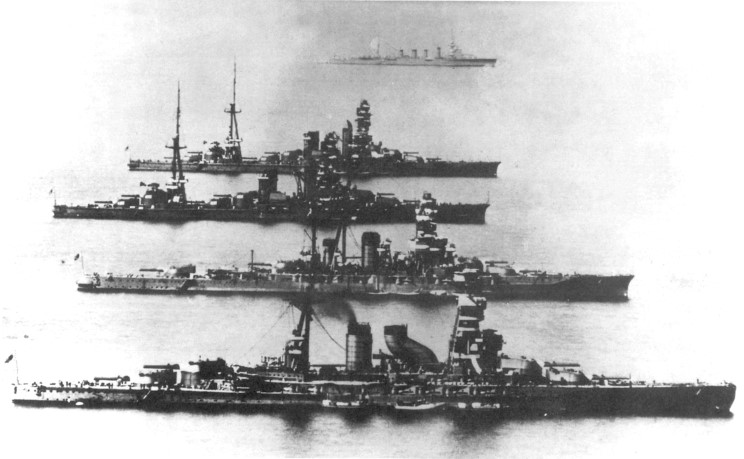
The IJN “battleship row” in the Yellow sea in the 1930s: Battleships Nagato, Kirishima, Ise and Huyga.
But what had not escaped the attention of historians and specialists, especially in light of the events that followed, was that Pearl Harbor had been a partial failure: On the one hand, none of the aircraft carriers of the fleet was sunk (By chance, being absent), but moreover, the oil tanks of the fleet remained intact, giving these same aircraft carriers the means to operate without delay. This error was dearly paid.
For a year, these few carriers, with a handful of cruisers, were going to hold firm, by tooth and nails in front of the Japanse armada, and even inflict a serious defeat at Midway, just the miracle that was needed for the American industry to catch up and eventually weigh down Japan.
Blitzkrieg in the Pacific
The Japanese Empire demonstrated that in terms of combined tactics, it had nothing to learn from its Nazi ally: In a few weeks, following Pearl Harbor, The Japanese Imperial Forces were going to capture all the important islands for strategic control of the Pacific.
To the west, it was going to carry the war to Indonesia and crush the weak Dutch navy assisted by British and Commonwealth ships (the ABDA force), then permanently disable the Royal Navy in the area by destroying in a stroke the flagship of the Singapore fleet, just arrived. A battle cruiser and an ultra modern battleship, recently illustrated against the Bismarck, and later, the only aircraft carrier dispatched to the scene (Hermes).
Singapore soon fell, as did the Philippines, Indonesia and Java. Then it was new guinea’s turn, and finally the Solomon Islands, the last wall protecting Australia. While the marines were distinguished by their tenacity despite a desperate situation at Guadalcanal, the IJN showed by its undeniable success that it had overall tactical mastery, both on land and at sea.

Crew training on Mutsu’s deck. The low-angle photo gives an idea of what will remain the largest “classic” warship of all time. This ship displaced 73,000 tons at full load. For comparison nothing came up close until the USS Enterprise of 1960 at 84,626 tons. Nowadays the USS Gerald Ford (100,000 tons) is the largest warship afloat.
In Santa Cruz, the IJN won a victory that was “Pyrrhic” in essence. At Midway, the swift and uncertain course of the naval air warfare – new for everyone, coupled with unfortunate decisions, the undeniable courage of pilots, as well as chance on the American side, turned a desperate situation into a true miracle. Japan lost not only many veteran pilots, but also four valuable aircraft carriers, while the American lost just one in the aftermath.
This was the key moment of the pacific war. It turned the tables in favor of the Americans, who took from then the initiative. This also started a long attrition war throughout the pacific. Japan was fighting to defend its island possessions, including precious raw materials supply lines vital for its industry, like oil and rubber… While on the American side it was seen as a grinding serie of landing operations bound to retrieve Japanese possessions close enough to bomb Japan, and the sine qua non condition for a total victory over such opponent.
Japanese fanaticism also set in motion the furious, savage, no-quarter given character to the fighting in the pacific until the end, with hatred from both sides. This was also probably the only conflict so spread out geographically that the last Japanese soldier, Hirō “Hiroo” Onoda was forced to surrender in 1974, until then hiding in the Philippine forest and waiting for orders.
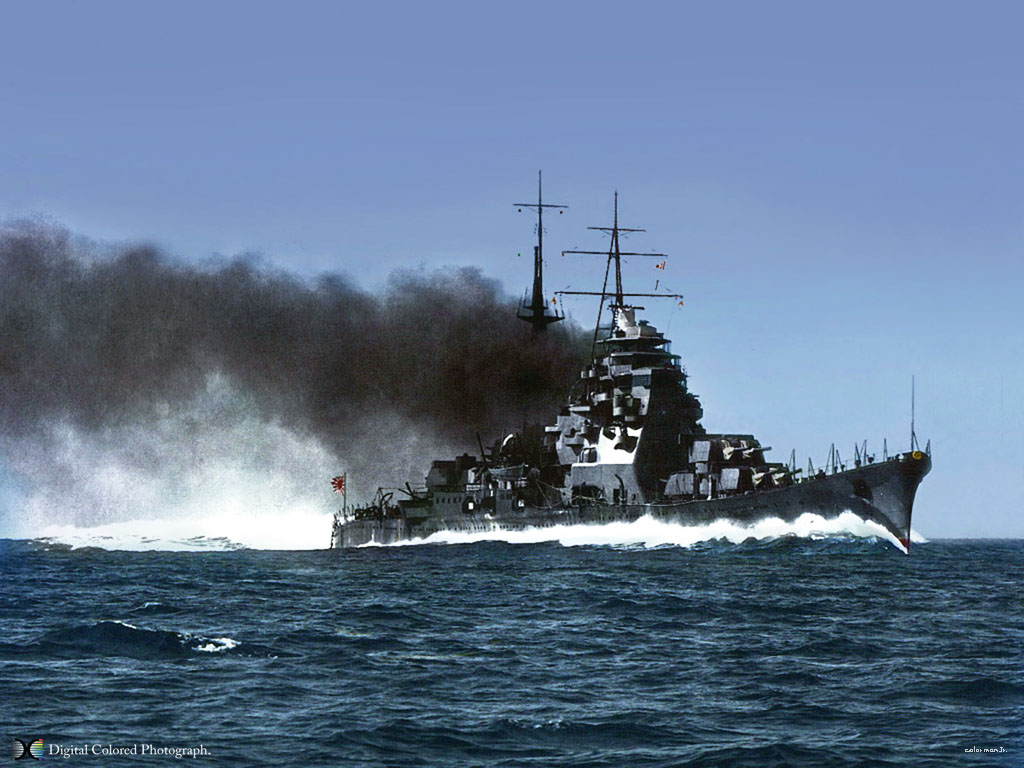
Colorized photo by Hirootoko Jr. of the IJN cruiser Takao. Not respecting Washington treaty’s clauses, Japanese Cruisers of the time were more strongly built (japanese steel), better armed, had better torpedoes (the famous “long lance”). The also had, crucially, better trained crews for night fighting and officers that were willing to apply overall complex tactics, asking for excellent coordination and seamanship. The “ironbottom sound” off Savo Island near Guadalcanal was emblematic of this.

A gigantic attrition war
The war in the Pacific was not a duel, but the engagement of a multitude of nations, a huge variety of theaters of operations, ranging from the deserts of China through the jungle of Borneo and icy mountains of the Aleutians. Next to the clash of infantry in Burma, Malaysia, New Guinea and China, it over all was the clash of two navies, with specialized infantry, US Marines and Japanese Navy troops. That was a contest of aircraft carriers, seaplanes, cruisers and destroyers.
But another side of this war is less known: The total was led by American submersibles against the IJN supply lines, from its centers of extraction of the south pacific to the metropolis. Submarines, freighters, tankers and vital escorts practiced a very different war, without large scale battles, but instead like the Atlantic, a long attrition process. It strangely mirrored German U-Bootes war against the British convoys, on reverse. In the same way, American units operated in packs and obtained prodigious successes during the war.
In addition to the aircraft carriers, battleships, cruisers and countless destroyers they sank, these submariners decimated the trade fleet, sending by the bottom dozens of tankers and hundreds of cargo ships loaded with precious resources, in effect starving Japanese industry. The last stage in this total was was to be close enough to home island for a relentless, merciless bombing campaign against civilian populations.

The momi II, Matsu-class escort destroyer. Despite laying the keel of some 150 escort destroyers from 1942, Japan never matched the American industry capabilities and ultimately would lost its ASW war and supplies.
The Japanese navy caught off-guard for ASW warfare, developed from 1943 a massive shipbuilding plan of escorts, simplified destroyers, corvettes and submersible chasers, as well as a very unique and innovative ASW autogyro carrier, the ancestor of ASW helicopter carriers. With the turn of events, this carrier tested a light reconnaissance autogyro equipped with 60kgs depht-charges, the Ki-1 model.
Also a number of civilian ships were converted into escort carriers like the Akitsu Maru and Ninjitsu Maru, former liners which became escort aircraft carriers. But their action was derisory compared to the mass of US submarines engaged: The “Gato” and its subclasses Balao and tench counted in all 77 units. This was small compare with the hundreds of U Bootes engaged (more than 1100 built during the conflict), but they were much larger (twice the tonnage, much roomier), had twice the radius of action and were in general much more succesful. Less spectacular however, this aspect of the Pacific War was just as important as amphibious operations.

Japanese K-1 type autogyro. These were used for reconnaissance, artillery-spotting, and anti-submarine uses. A squadron was operational on board Akitsu Maru, an Army-operated escort carrier which served from August to November 1944 when she was sunk.
Leyte: The mother of all naval battles
The largest naval battle since Trafalgar and Aboukir perhaps, and Jutland in ww1, was a massive engagement spanning several day and comprising several sub-battles generally assimilated as the “battle of Leyte”. It has been said that the combined and somewhat unexpected attack of the Japanese fleet during the operations of the Marianas and the Philippines in 1944 could compared to a naval version of the battle of the bulge or even a “naval kursk”. It was indeed a massive gamble, led this time by old school admirals. The Marianas and Palau, outposts protecting the east flank of the Philippines were now targeted. These were the last great stronghold of the Japanese Pacific forces. The air war was a fatal blow for the IJN aviation, which literally threw in its last strength, rare veterans but many young, inexperienced pilots who had succeeded them.
Opposite were American veteran pilots and now excellent fighters, the Hellcats and Corsairs. By the time of the Battle of Leyte, Japan had gathered the rest of its available forces in a gigantic pincer manoeuver resting on three fleets: A spearhead, the “hammer” consisting of heavy units (the central force of Kurita, arriving north of Palawan), the “anvil” represented by the combined forces of Shima and Nishimura attacking from the south, north of Mindanao, and finally the bait force commanded by Ozawa, arriving from the north and composed mainly of aircraft carriers (without aircraft) intended to divert the attention of the formidable 3rd fleet commanded by “Bull” Halsey, covering the amphibious operations.
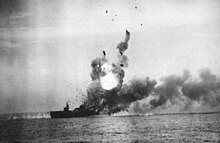 Fact is, this risky operation for the IJN nearly succeeded. As expected, Halsey fell for the bait, and driving north in pursuit of Ozawa, while the formidable “hammer” of Kurita, very skillfully maneuvering between the islands, fell without warning on the feeble Taffy 3 which was then left protecting the American landing: A handful of escort aircraft carriers or “jeep carriers” and their close guard, destroyers and escort destroyers.
Fact is, this risky operation for the IJN nearly succeeded. As expected, Halsey fell for the bait, and driving north in pursuit of Ozawa, while the formidable “hammer” of Kurita, very skillfully maneuvering between the islands, fell without warning on the feeble Taffy 3 which was then left protecting the American landing: A handful of escort aircraft carriers or “jeep carriers” and their close guard, destroyers and escort destroyers.
But the Japanese did not expected the stubborn resistance of the destroyers, which were all destroyed or damaged in the process, but held enough Kurita to retreat, having lost two major units and having others damaged or out of action. A “David against Goliath” who earned surviving crews a rain of presidential citations. The situation that prevailed at Guadalcanal could have happened again. After this, Japanese troops of the Philippines were also greater in numbers compared to the Americans. But miraculously, the bridgehead supported by the survivors of the Taffy 3, held firm. No new action of this magnitude was repeated on the Japanese side, which definitively lost both interest and assets to conduct another major action. The lack of pilots and fuels played also a vital role in this state of affairs. Then began the last and most desperate phase of the war: The massive use of Kamikaze, human missiles.
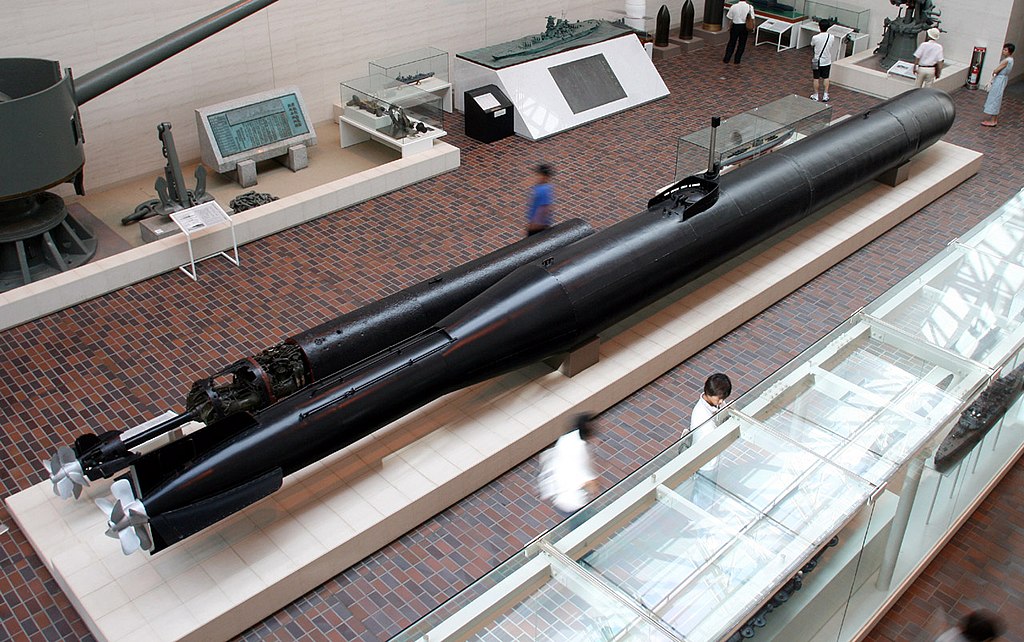
Kaiten Type 1 Yushukan at the Tokyo Yasukuni War Memorial Museum. Just like Germany with its midget submarines, the Japanese produced hundreds of midget submarines and human torpedoes to stem the flow of American ships, but with very limited success, if any.
Kamikaze and Secret Weapons
 From the end of 1944 began the hardest, most bitter and bloody engagements of the Pacific War, getting closer to Japan itself.
From the end of 1944 began the hardest, most bitter and bloody engagements of the Pacific War, getting closer to Japan itself.
Tarawa, Saipan, then Iwo Jima and finally Okinawa. The Japanese aviation, deprived of fuels and experienced pilots was soon able to intervene other than in the form of suicide raids, the famous kamikazes (“divine wind”). These raids that terrified the Americans and actually sank or damaged a lot of ships, not least:
Carriers were indeed a preferred target because of their size and importance. The pilots, from all walks of life and not inexperienced as we have often said, took the sake in honor of the emperor before taking off, ritual ceremony, then sometimes loaded with bombs to maximize the effect of their impact, tried to crash on the deck or hull of American buildings. The escort aircraft carrier USS St Lo was sunk, the USS Enterprise and Bunker Hill, very seriously affected, were put out of action until the end of the war.
The first raid, led by Lieutenant Seki was conducted in Leyte in October 1944 and was successful. The largest of these raids occurred in Okinawa during Operation Kikusui, with nearly 400 aircraft. While many aircraft were shot down, the Americans lost 7 ships while 200 were more or less seriously affected.
Kamikaze attacks were often much more effective than conventional attacks. The same operation was followed by the Ohka (“baka”), the first specialized suicide planes with a rocket engine that was lit when the aircraft was deployed in the area from a Mitsubishi G4M “Betty” parent bomber. The planes were not the only suicide weapons deployed: The Japanese put into service from the mid-44 several models of “Kaiten” piloted torpedoes, deployed from submersibles and reformed destroyers.
The only tangible success was the destruction of the tanker USS Mississinewa in November 1944. Many Kaiten were however produced and deployed in 1945 on the coast of Japan. Shinyo suicide stars were also deployed, shortly before the atomic bomb was dropped, battalions of “suicide swimmers” loaded with explosives.

From 1944 and particularly after the battle of Leyte, the Kamikaze tactic was systematically used, with sometimes impressive results. Reports was taken in account when designing the first postwar antiship missiles.
The end of the Japanese empire
The deployment of the Yamato in its last “no return” exit destined to fail Okinawa (Ten-go operation) to use its artillery against the US landing force was killed in the egg by naval air in March 1945. This was one of the last serious attempts to counter American operations.
The bulk of the Japanese navy was now permanently anchored in Kure, the large military arsenal in southern Japan, which began to suffer massive US Navy air strikes from January 1945, culminating in July 1945, in preparation for the Olympic operation. For 4 days, uninterrupted raids from the US and British task forces spraying the installations and sinking everything that remained afloat, including aircraft carriers, battleships, cruisers, destroyers and countless other buildings. It was a “pearl harbor on the back”.
Although the Americans could have chosen as allies at the end of the Great War, depriving Japan of any chance to rebuild an army, the country, then under guardianship, was used as the advanced base of the US Navy in the Pacific , and his naval rearmament carried out under the banner of a “self-defense force”. Its strategic position made it an essential ally during the Cold War. The Nippon Navy has since gained importance both by the tonnage of its buildings and their nature.
Symbolically, no aircraft carrier was built, and it was only recently, in March 2009, that the Hyuga class, officially called “helicopter-destroyers”, was launched, but their large size and equipment make them apt to implement. AV8 Harrier 2.
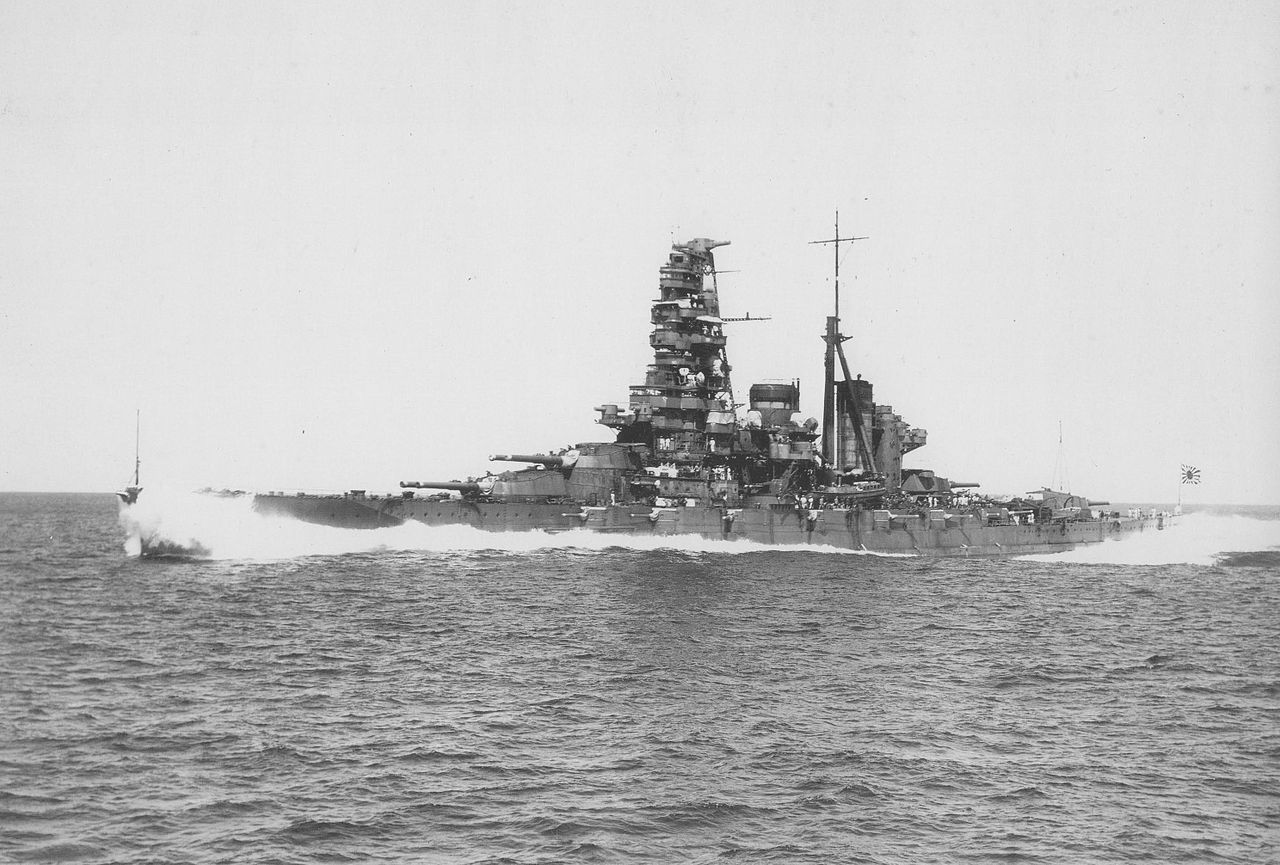
Battleship Haruna
The Imperial Japanese Navy ships in detail
12 Battleships:
10 in December 1941, 1 completed, 2 in construction
-KONGO class fast battleships (1912): 4: Kongo, Haruna, Hiei, Kirishima
-FUSO class fast battleships (1915): 2: Fuso, Yamashiro
-ISE class fast battleships (1917): 2: Isa, Hyuga
-NAGATO class fast battleships (1919): 2: Nagato, Mutsu
–wartime—————————————-
-YAMATO class battleships (Yamato in service 16 December 1941, Musashi in completion 5 August 1942, 2 others)

Japanese Battleship Nagato in brunei, October 1944
32 Aircraft Carriers:
10 in December 1941, 22 more until 1945
–Hosho (1919)
-Akagi (1927)
-Kaga (1928)
-Ryujo (1931)
-Soryu (1935)
-Hiryu (1937)
-Shokaku class (1939): Shokaku Zuikaku
-Zuiho class (1940): Zuiho, Soho.
–wartime————————————
-Ryuho (1933): Converted supply ship in 1942
-Junyo class (1941): converted liners Junyo and Hiyo
-Taiho (1943): Large tailor-built aircraft carrier
-Chitose class (converted 19343): Chitose, Chiyoda, Mizuho
-Shinano (1944): Large fleet armoured aircraft carrier
-Unryu class (1944): Unryu, Amagi, Katsuragi, Kasagi, Aso and Ikoma.
-Taiyo class (Converted freighters 1944): Taiyo, Unyo, Chuyo.
-Kaiyo (1944)
-Shinyo (1944)
-Yamashio Maru class ASW escort carrier: 1(1)
-Akitsu Maru ASW escort carrier: Akitsu Maru, Kumano Maru
-Ibuki (cruiser conversion Project)

Aircraft carrier Ibuki, almost completed.

IJN cruiser Haguro and its Nakajima E8N Type 95 “Dave” reconnaissance seaplane in the yellow sea, 1936. Colorized photo by Hirootoko jr.
43 Cruisers:
38 in December 1941, 5 more until 1945
-Tenryu class (1919): Tenryu, Tatsuta
-Kuma class (1921): Kuma, Tama, Kitakami, Oi, Kiso
-Nagara class (1921): Nagara, Isuzu, Natori, Yura, Kinu, Abukuma
-Sendai class (1923): Sendai, Jintsū, Naka, Kako
-Yubari (1923)
-Furutaka class (1925): Furutaka, Kako
-Aoba class (1926): Aoba, Kinugasa
-Nachi class (1927): Nachi, Myoko, Ashigara, Haguro
-Takao class (1930): Takao, Atago, Maya Chokai
-Mogami class (1934): Mogami, Mikuma, Suzuya, Kumano
-Tone class (1937): Tone, Chikuma
-Katori class (1939): Katori, Kashima et Kashii
—-Wartime: —————————-
-Agano class (1941): Agano, Noshiro, Yahagi, Sakawa
-Oyodo (1942)

Colorized photo of the Agano, by Hirootoko jr.
200+ Destroyers:
124 in December 1941, 78 more until 1945
-Minekaze class (1919): 15
-Momi class (1919): 21
-Kamikaze class (1922): 9
-Mutsuki class (1925): 12
-Fubuki class (1927): 19
-Akatsuki class (1932): 4
-Hatusharu class (1932): 6
-Shiratsuyu class (1935): 10
-Asashio class (1936): 10
-Kagero class (1938): 18

IJN destroyers in 1941, colorized by Hirootoko jr.
–wartime————————————–
-Yugumo class (1941): 19
-Shimakaze class (1942): 16
-Akitsuki class (1941): 11
-Matsu class escort (1944): 18
-Tachibana class escort (1944): 14
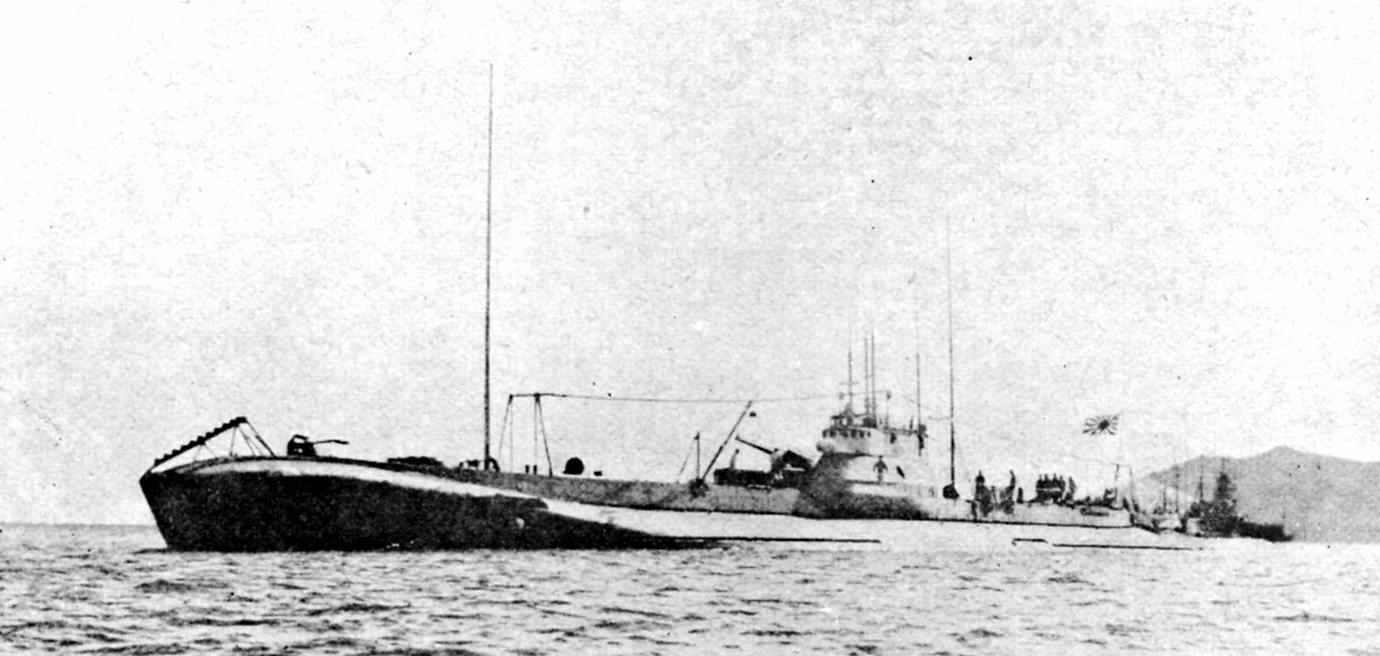
900+ Submarines:
67 in December 1941, 832 more until 1945
-L4 class (1922): 9
-J class (1924): 8 (J1-J3)
-KRS class (1926): 4
-A class (1938): 6 (A1, A2, AM)
-B class (1939): 29 (B1-B3)
-C class (1939): 11 (C1-C3)
———————————————–
-D1 class (1943): 12(+2 D2 incomplete)
-KD class (1942): 35 (KD1-KD7)
-KS class (1942): 18
-K class (1942): 20 (K5, K6)
-STO class (1944): 3
-STS class (1945): 10(16+50)
-ST class (1945): 3(6)
-SH class (1945): 1(2)
-Yu1 class (1944): 12
-Yu1001 class (1945): 14
-SS class (1945): 4(12)
-Midget submarines Ko-Hyoteki: 50
-Midget submarines Kairyu Type: 250
-Kaiten Type human torpedoes: 400

Escort ship Nomi, Mikura class 1944
190 Miscellaneous ships:
TBs and escort ships
-Tomozuru/Otori class TBs (1933): 12
-Shimushu/Type A escorts (1939): 4
-Erotofu/Type A (1942): 14
-Mikura/Type B (1942): 8
-Uruku class/Type B (1942): 29(142)
-Type C (1943): 56(300)
-Type D (1944): 67(203)
34 Minelayers
-Shirataka (1929)
-Itsukushima (1929)
-Kamome class (1929): 2
-Yaeyama (1931)
-Nasami class (1933): 2
-Okinoshima (1935)
-Sokuten/Harashima/Ajiro class (1938): 16
-Hatsutaka class (1939): 3
-Kamishima class (1945): 2
-Hatsushima class (1940): 4
41 Minesweepers
-W1 class (1923)
-W5 class (1928)
-W13 (1933)
-W17 (1935)
-W7 (1938)
-W19 (1941)
22 Gunboats
Toba (1911)
Seta class (1913): 4
Ataka (1922)
Atami class (1928): 2
Saga (1932)
Hashidate class (1939): 2
Fushimi class (1939): 2
Kotaka (1940)
Captured gunboats Tarara, nanyo, Nankai, Okitsu, Karatsu, Shima, maiko, Barumi
1400 Amphibious ships
-Kumano Maru assault aircraft carrier (1944)
-Shinshu Maru Landing Craft Depot Ship (1935)
-Type T1 (1944): 21
-Type T101/103 (1944): 70
-SS type landing crafts (1942-44): 22
-Daihatsu class landing crafts (1942): 1300

Ashizuri on sea trials at Nagasaki
11 Seaplane carriers
-Notoro (1920)
-Kamoi (1922)
-Chitose class (1936) – converted 1942
-Mizuho (1938)
-Nisshin (1939)
-Akitsushima (1941)
-Shimane Maru class (1944)
-Yamashiro Maru class (1935)
56 Submarine chasers
-CH1 class (1935): 2
-Ch3 class (1936): 10
-CH51 class (1936): 2
-CH13 class (1940): 42
Japanese Motor torpedo boats
-19 metre class (1940)
-T1 class (1941)
-T23 class (1943)
-T14 class (1944)
-T15 class (1944)
-T51 class (1942)
-H class gunboat launches (1942)
-19/15m class launches (1936)
-Type 25t class launches (1940)
-Shinyo class suicide boats (1944)
Links & resources
en.wikipedia.org/wiki/Submarines_of_the_Imperial_Japanese_Navy
Conway’s all the world fighting ships 1922-1946
http://fr.naval-encyclopedia.com/2e-guerre-mondiale/nihhon-kaigun.php#cuir
3d Corner
https://www.cgtrader.com/3d-models/watercraft/military/battleship-fuso

 Latest Facebook Entry -
Latest Facebook Entry -  X(Tweeter) Naval Encyclopedia's deck archive
X(Tweeter) Naval Encyclopedia's deck archive Instagram (@navalencyc)
Instagram (@navalencyc)





 French Navy
French Navy Royal Navy
Royal Navy Russian Navy
Russian Navy Armada Espanola
Armada Espanola Austrian Navy
Austrian Navy K.u.K. Kriegsmarine
K.u.K. Kriegsmarine Dansk Marine
Dansk Marine Nautiko Hellenon
Nautiko Hellenon Koninklije Marine 1870
Koninklije Marine 1870 Marinha do Brasil
Marinha do Brasil Osmanlı Donanması
Osmanlı Donanması Marina Do Peru
Marina Do Peru Marinha do Portugal
Marinha do Portugal Regia Marina 1870
Regia Marina 1870 Nihhon Kaigun 1870
Nihhon Kaigun 1870 Preußische Marine 1870
Preußische Marine 1870 Russkiy Flot 1870
Russkiy Flot 1870 Svenska marinen
Svenska marinen Søværnet
Søværnet Union Navy
Union Navy Confederate Navy
Confederate Navy Armada de Argentina
Armada de Argentina Imperial Chinese Navy
Imperial Chinese Navy Marinha do Portugal
Marinha do Portugal Mexico
Mexico Kaiserliche Marine
Kaiserliche Marine 1898 US Navy
1898 US Navy Sovietskiy Flot
Sovietskiy Flot Royal Canadian Navy
Royal Canadian Navy Royal Australian Navy
Royal Australian Navy RNZN Fleet
RNZN Fleet Chinese Navy 1937
Chinese Navy 1937 Kriegsmarine
Kriegsmarine Chilean Navy
Chilean Navy Danish Navy
Danish Navy Finnish Navy
Finnish Navy Hellenic Navy
Hellenic Navy Polish Navy
Polish Navy Romanian Navy
Romanian Navy Turkish Navy
Turkish Navy Royal Yugoslav Navy
Royal Yugoslav Navy Royal Thai Navy
Royal Thai Navy Minor Navies
Minor Navies Albania
Albania Austria
Austria Belgium
Belgium Columbia
Columbia Costa Rica
Costa Rica Cuba
Cuba Czechoslovakia
Czechoslovakia Dominican Republic
Dominican Republic Haiti
Haiti Hungary
Hungary Honduras
Honduras Estonia
Estonia Iceland
Iceland Eire
Eire Equador
Equador Iran
Iran Iraq
Iraq Latvia
Latvia Liberia
Liberia Lithuania
Lithuania Mandchukuo
Mandchukuo Morocco
Morocco Nicaragua
Nicaragua Persia
Persia San Salvador
San Salvador Sarawak
Sarawak Uruguay
Uruguay Venezuela
Venezuela Zanzibar
Zanzibar Warsaw Pact Navies
Warsaw Pact Navies Bulgaria
Bulgaria Hungary
Hungary

 Bundesmarine
Bundesmarine Dutch Navy
Dutch Navy Hellenic Navy
Hellenic Navy Marina Militare
Marina Militare Yugoslav Navy
Yugoslav Navy Chinese Navy
Chinese Navy Indian Navy
Indian Navy Indonesian Navy
Indonesian Navy JMSDF
JMSDF North Korean Navy
North Korean Navy Pakistani Navy
Pakistani Navy Philippines Navy
Philippines Navy ROKN
ROKN Rep. of Singapore Navy
Rep. of Singapore Navy Taiwanese Navy
Taiwanese Navy IDF Navy
IDF Navy Saudi Navy
Saudi Navy Royal New Zealand Navy
Royal New Zealand Navy Egyptian Navy
Egyptian Navy South African Navy
South African Navy






























 Ukrainian Navy
Ukrainian Navy dbodesign
dbodesign